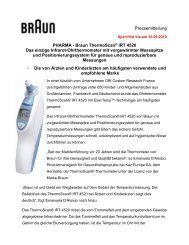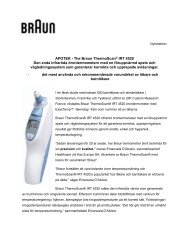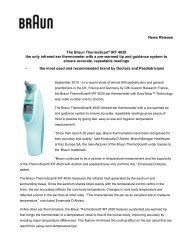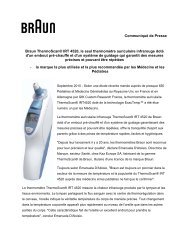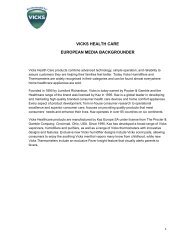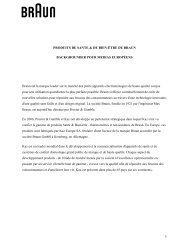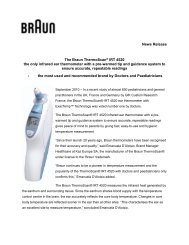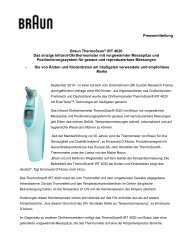BRAUN – Media Backgrounder EN - KAZ Europe
BRAUN – Media Backgrounder EN - KAZ Europe
BRAUN – Media Backgrounder EN - KAZ Europe
You also want an ePaper? Increase the reach of your titles
YUMPU automatically turns print PDFs into web optimized ePapers that Google loves.
<strong>KAZ</strong> SA’S GUIDE TO HYPERT<strong>EN</strong>SION AND BLOOD PRESSURE MONITORS<br />
1. What is Hypertension?<br />
Hypertension is a very common health threat and is the medical condition of having consistently<br />
high blood pressure. Blood pressure is the force that blood exerts on artery walls as it circulates<br />
through the body. Blood fills arteries to a certain capacity, like air in a tyre. If there is too much<br />
air, the air pressure can damage the tyre. In the same way, high blood pressure can damage<br />
arteries and lead to life-threatening diseases.<br />
A doctor must diagnose hypertension, but blood pressure can be tracked at home with a home<br />
blood pressure monitor. If the readings over a period of time are persistently above given limits,<br />
users should consult their doctor immediately.<br />
2. The readings - systolic and diastolic pressure<br />
Blood pressure monitors give two readings: systolic and diastolic pressure. The values are<br />
expressed in millimetres of mercury (mmHg). Most blood pressure monitors also show the heart<br />
rate.<br />
Systolic pressure is the maximum blood pressure. It represents the pressure on the arteries<br />
when the heart contracts and pumps blood into them. Diastolic pressure is the minimum blood<br />
pressure, which is recorded when the heart relaxes after contracting and draws blood back into<br />
its chambers. For further information, refer to www.medicinenet.com or www.medterms.com.<br />
According to the World Health Organization, hypertension occurs when consistent readings of<br />
over 140/90 mmHg (this is read as “140 over 90″, where 140 is the systolic pressure and 90 is<br />
the diastolic pressure) are reached. It is also possible to have systolic hypertension or diastolic<br />
hypertension if only one of these levels is high.<br />
3. Home measurement<br />
The <strong>Europe</strong>an Society of Hypertension encourages people who suffer from high blood pressure<br />
to measure their blood pressure regularly at home. This improves patients’ adherence to<br />
treatment and provides more information on its effectiveness.<br />
• Upper arm blood pressure monitor. This is the place where a doctor measures blood<br />
pressure, and this type of monitor can also be uses at home. The strap is placed around the<br />
upper arm and the button is pressed. The strap automatically inflates and then deflates slowly.<br />
During deflation, when blood pressure equals the pressure in the strap, the monitor displays the<br />
systolic and diastolic readings together with the pulse.<br />
• Wrist blood pressure monitor. These are very small and easy to use. Firmly wrap the<br />
strap around the wrist so that the screen is on the inside of the wrist, and press the button. The<br />
8



